
Andy Lloyd's Dark Star Blog

Blog 40 (July 2016)
Interstellar Planet Formation
Continuing the discussion from last month's blog about planetessimal-building conditions in space beyond the solar system's heliopause boundary (1). In my February paper, I discussed anomalous results which had come back from various space probes regarding the influx of large grain interstellar dust into the heliosphere (2). More on this in a moment.
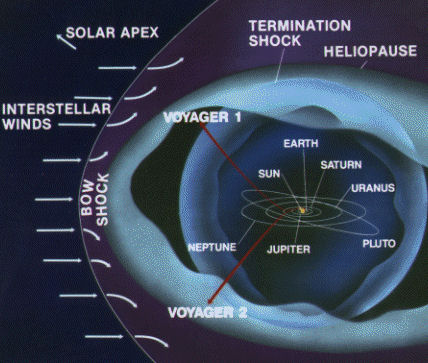
Image credit: JPL (NB: This is slightly outdated as it is now thought that the 'bow shock' is more like a gentle 'bow wave' (7,8))
A correspondent of mine had noted similarities between what I had been writing about and previous work by Paul LaViolette, who had written about the origins of the dust picked up by the Ulysses spacecraft:
"I would suggest that the dust originates from a circumsolar dust sheath that is concentrated toward the plane of the ecliptic in a fashion similar to the disk girdling the star Beta Pictoris and that is co-moving with the Sun. Infrared observations confirm the existence of dust sheaths around other stars in the solar neighborhood, leading to the conclusion that our Solar System is similarly shrouded." (3)
The 20 million year old star Beta Pictoris provides astronomers with the best example of a gas giant exoplanet found orbiting within an evolving proto-planetary disk, made all the more dramatic by its side-on view and the brightness of scattered light from the revolving disk:
"In 1984 Beta Pictoris was the very first star discovered to host a bright disc of light-scattering circumstellar dust and debris. Ever since then Beta Pictoris has been an object of intensive scrutiny with Hubble and with ground-based telescopes. Hubble spectroscopic observations in 1991 found evidence for extrasolar comets frequently falling into the star." (4)
Such a theme is also explored, at last from the point of view of how the solar system might have appeared early in its history, by astrophysicist Dave Jewitt in his highly informative online article about the Edgeworth-Kuiper Belt:
"One suggestion is that the depletion of the Kuiper belt could have been caused by extensive collisional grinding of the objects into dust. The dust would have temporarily given the Solar system a ring-like appearance as observed in the debris disks of nearby stars (Moro-Martin et al. 2007, Wyatt 2008) but, over time, the dust would have been swept away by radiation forces. Alternatively, some suppose that the Kuiper belt was dynamically depleted, presumably by interactions with Neptune." (5)
Dr Jewitt describes how there is an 'armada' of in-falling dust and other debris from the Kuiper Belt created by the continuous risk of collisions among the literally trillions of objects which make up the Kuiper Belt. This interplanetary dust has been detected by various spacecraft, and extends deeply back through the planetary zone of the solar system. That said, the Kuiper Belt lies well within the heliosphere. It is what is going on beyond which is of keen interest.
My contention, as well as that of Paul LaViolette before me, is that beyond the heliopause such depletion by radiation forces does not take place, leaving an extant sheath of dust. I am arguing, further, that this sheath is gradually swept up by planetary bodies lying beyond the heliopause to create dust disks around them, and that this sheath of interstellar dust is periodically rejuvenated when the solar system moves through areas of relatively dense dust clouds interspersed throughout the galaxy.
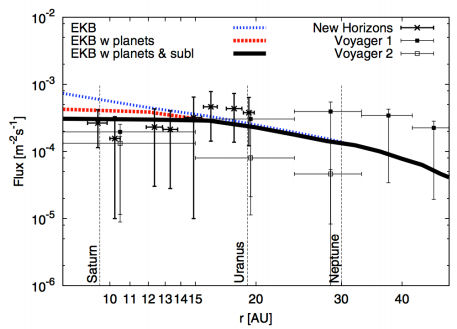
The flux of dust grains impacting spacecraft in the outer solar system (5).
The impact flux corresponds to dust production rate of two tonnes per second.
From Vitense et al. (2012) (6)
You might reasonably ask how such a sheath might have avoided direct detection? In this context, it's interesting to note that the Kuiper Belt is also thought to have a debris cloud, but one that has not been directly detected because of the 'zodiacal light' reflected back at us from interplanetary dust in the foreground:
"In contrast to all other debris disks, where the dust can be seen via an infrared excess over the stellar photosphere, the dust emission of the Edgeworth-Kuiper belt (EKB) eludes remote detection because of the strong foreground emission of the zodiacal cloud." (6)
If that's the case for a debris dust disk thought to exist in the Kuiper Belt, then it most assuredly applies to any extensive dust disk lying beyond the heliosphere, which is located about twice the distance away. Simply put, if such a sheath of dust exists beyond the heliopause, then the comparatively bright foreground light of the interplanetary dust in the inner solar system is effectively preventing its detection. Only a spacecraft moving beyond the heliopause with dust-detecting equipment will know for sure.
The only probes exploring beyond the heliopause at the moment are the Voyager spacecraft, with the Pioneers somewhat behind them. The Voyager spacecraft are not equipped with actual dust detectors, but will record the electric effects of the plasma cloud generated during the high velocity impact between dust and spacecraft, and even potentially pick up evidence of charged particles passing between their electric antennae.
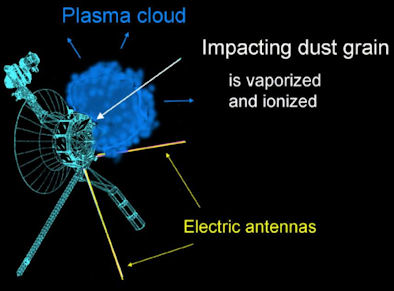
The expanding plasma cloud resulting from high speed impact with dust particles is detected across Voyager's electric antenna array (9)
However, interpreting this data is not necessarily very straightforward:
"On November 13,1980, the spacecraft Voyager 1 passed through Saturn's E ring - a faint dusty structure having a rather large radial extension and thickness. The Voyager spacecraft did not carry conventional dust detectors, but they carried two wave instruments designed for measuring radio and plasma waves. Both instruments recorded dust signals, but this was recognised much later because the plasma played a dirty trick: genuine dust signals were mixed with intense plasma waves, and that made them difficult to interpret." (9)
As interstellar medium, including dust, likely takes the form of diffuse plasma, then these spacecraft are still capable of sending back data about what they're encountering as they shoot through the heliosheath zone. There are complications, though. Larger particles of particulate matter will be mixed in with what is presumed to be a steady flow of interstellar plasma. Furthermore, the rather archaic data return from the Voyager craft these days is necessarily limited by the reducing power output of their slowly dying batteries as their nuclear fuels are depleted. Nonetheless, scientists were still able to ascertain that Voyager entered an unexpected, but immense cloud of interstellar plasma held together by a strong magnetic field (10):
"Astronomers call the cloud we're running into now the Local Interstellar Cloud or "Local Fluff" for short. It's about 30 light years wide and contains a wispy mixture of hydrogen and helium atoms at a temperature of 6000 C. The existential mystery of the Fluff has to do with its surroundings. About 10 million years ago, a cluster of supernovas exploded nearby, creating a giant bubble of million-degree gas. The Fluff is completely surrounded by this high-pressure supernova exhaust and should be crushed or dispersed by it.
"The observed temperature and density of the local cloud do not provide enough pressure to resist the 'crushing action' of the hot gas around it," says [Merav]
Opher [a NASA Heliophysics Guest Investigator from George Mason University]. So how does the Fluff survive? The Voyagers have found an answer. "Voyager data show that the Fluff is much more strongly magnetized than anyone had previously suspected—between 4 and 5 microgauss," says Opher. "This magnetic field can provide the extra pressure required to resist destruction." (11)Perhaps the issue here is more to do with the perceived density of this cloud, at least at a very local level. The zones beyond the heliosphere may be awash with interstellar clouds; even flowing rivers of interstellar plasma. But what about denser, heavier materials? What about larger grained material which is not ionised into plasmas?
An anomalously high level of large dust grains has been observed by the Ulysses, Cassini and Galileo satellites, which moves with the ISM flow towards the inner solar system. This effect has yet to be satisfactorily explained, and implies that there is an unexpected source for these particles beyond the heliosphere (12). Calculations, based upon certain assumptions, indicate a possible source ranged some 500 AU away (13), well beyond the heliosheath zone.
Astrophysicists interested in debris disks in the outer solar system have done modelling on whether dust can clump together at the distance of the Kuiper Belt. They have found from their calculations that dust which falls into a resonant orbit with Neptune can indeed clump, forming larger particles of debris matter which can statistically withstand the opposing mechanisms of collisional cascades (14).
(Such collisional cascades are thought to account for an observed dust cloud surrounding a presumed giant exoplanet lying in the extensive debris disk orbiting the star Formalhaut (15)).
In other words, dust in the Kuiper Belt can, under certain conditions, begin to accrete - at least hypothetically, anyway. Such a mechanism has not been detected directly, for the same reasons described above - interplanetary Zodiacal dust blinds us to more subtle effects beyond, in the same way street lighting impedes stargazing. What's important here is the shepherding influence of a major nearby planet which, in the case of the Kuiper Belt, is Neptune.
So, one would assume that a similar catalyst would be required beyond the heliopause. One requires the influence, then, of a Planet Nine (16), Planet X or Dark Star object. Such a mechanism may explain the anomalous influx of materials from beyond the heliopause, and provide an on-going process of planet-building in interstellar space.
Written by Andy Lloyd, 8th-17th July 2016
References:
1) Andy Lloyd "Dust in the Winged" 23 June 2016
andylloyd.org/darkstarblog39.htm
2) Andy Lloyd "The Cumulative Effect of Intermittent Interstellar Medium Inundation Upon Objects In The Outer Solar System" Feb 2016, DOI: 10.13140/RG.2.1.5112.5526 - an updated version (22/2/16) is available here:
3) Paul LaViolette "Anticipation of the Ulysses Interstellar Dust Findings" Eos 74(44) (1993): 510-11, with thanks to Michael
4) Astronomy Now "Hubble sees pulverised planet in Beta Pictoris debris disc?" 23 February 2015
5) David Jewitt "The Kuiper Belt: What We Know and What We Don’t" September 2012
6) Christian Vitense et al. "An improved model of the Edgeworth-Kuiper debris disk" Astronomy and Astrophysics, 540: A30, 7 February 2012
7) PhysOrg "New Interstellar Boundary Explorer data show heliosphere's long-theorized bow shock does not exist" 10 May 2010
8) D. J. McComas "The Heliosphere's Interstellar Interaction: No Bow Shock" Science, 10 May 2012
9) Nicole Meyer-Vernet "Detecting Dust with Electric Sensors in Planetary Rings, Comets and Interplanetary Space" Spacecraft Charging Technology, Proceedings of the Seventh International Conference held 23-27 April, 2001 at ESTEC. Ed. R.A. Harris, ESA SP-476, 2001, p.635
10) Merav Opher, et al "A strong, highly-tilted interstellar magnetic field near the Solar System," Nature, 462: 1036-1038, 24 December 2009
11) Tony Phillips "Voyager Makes an Interstellar Discovery" 23 December 2009
12) B.T. Draine, B.T. "Perspectives on Interstellar Dust Inside and Outside of the Heliosphere", Space Science Reviews, 143:1, pp 333-345, March 2009
13) Mikhail Belyaev & Roman Rafikov "The Dynamics of Dust Grains in the Outer Solar System", The Astrophysical Journal, 723:1718–1735, 10 November 2010,
14) Christian Vitense et al. "Will New Horizons see dust clumps in the Edgeworth-Kuiper belt?" The Astronomical Journal, 147: 6, 9 May 2014,
15) Scott Kenyon, et al. "Fomalhaut b as a Cloud of Dust: Testing Aspects of Planet Formation Theory", The Astrophysical Journal, 786 (1), 20 March 2014,
16) Konstantin Batygin & Michael Brown "Evidence for a Distant Giant Planet in the Solar System" The Astronomical Journal, 151:2, 20 January 2016,
New Dwarf Planet Sparks Debate about Planet Nine
The
family of extended scattered disk objects beyond the classical Kuiper
Belt just keeps getting bigger. The latest addition to this
population of objects is a fairly substantial dwarf planet 700km across,
currently referred to by the moniker
2015 RR245 takes approximately 700 years to orbit the Sun. 2015 RR245 was discovered by National Research Council of Canada’s Dr J.J. Kavelaars while studying images taken by Canada–France–Hawaii Telescope in Hawaii in September 2015 .
Rendering of the orbit of RR245 (orange line).
The blue circles show the
projected orbits of the major planets.
Image credit: Alex Parker OSSOS
team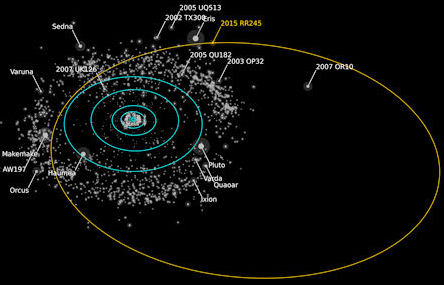
Does this object fit in with Mike Brown's analysis of the cluster of 6 (now 7) Sednoid objects which he argues (along with his dynamicist colleague Konstantin Batygin) point to the existence of a substantial planet beyond the Kuiper Belt (3)? Given the vague data regarding the orbit of 2015 RR
245, it is perhaps too early to say. But other scientists are already citing the on-going discoveries of distant objects like 2015 RR245 as reasons to be cautious.In an informative on-line article, more nuanced than its title suggests, astrophysicist Ethan Siegel notes that the pattern of discovery of objects within and beyond the Kuiper Belt is subject to an observational bias favouring the closest objects. This means that the unknown populations of objects yet to be discovered may eventually statistically overwhelm the small populations of extended scattered disk objects and Sednoids already discovered. This, he argues, could bring Brown and Batygin's analysis of the cluster into question.
Such an argument does not directly address the statistical fluke generated by the original clustering of six Sednoids, which were later joined in March 2016 by a seventh, uo3L91 (5). Instead, Siegel's argument simply implies that this fluke could be overwhelmed by a much broader data set attained at a later point. But this is irrelevant, because 2015 RR245 actually enjoys a 9:2 resonance relationship with Neptune, and so is not a member of the same set of objects which has caused this controversy (6). Siegel's argument is contested here by Dr Bannister:
"[Michele]
Bannister [an astronomer at the University of Victoria in British Columbia] stirred up some buzz in March when she presented data about a different object in the far reaches of the solar system, known as uo3L91. At the time, Caltech astronomer Mike Brown – who was part of a team that discovered Eris back in 2005 – said the object’s far-flung orbit could serve as evidence for the existence of a super-distant super-Earth he dubbed “Planet Nine.” However, Bannister said 2015 RR245 has no connection to the case of uo3L91 or the search for Planet Nine." (7)It does seem, though, that each new object discovered beyond the Edgeworth-Kuiper Belt is going to generate this kind of debate: Does its presence help, hinder, or utterly fail to impact upon the potential existence of Planet Nine?
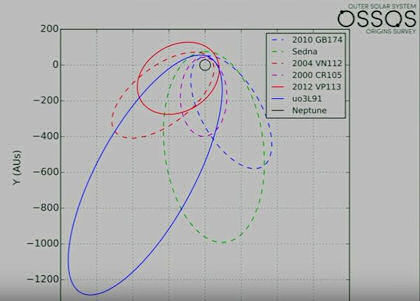
Data from Outer Solar System Origins Survey (OSSOS) (8)
Another aspect to consider here is that the Caltech team seem to consider the population of these anomalous clustered objects to be a dynamic one, rather than a static collection held forever in thrall of Planet Nine. A newly-published on-line article by Konstantin Batygin traces the evolution of the thinking behind Planet Nine, and describes in some detail the rather odd dynamic patterns of resonance which the Sednoids have with his (and Dr Brown's) proposed distant planet (9).
It seems reasonable that larger-than-dwarf planets might be captured up in to extended scattered disk of Sednoids in this way, but what's interesting is that Brown and Batygin envision a fluctuating population of Sednoids where Kuiper Belt Objects are pulled up into the scattered disk for a while, before falling back once more into the regular disk, to be replaced by others which experience similar perturbations:
"Surprising and unforeseen results continued to accrue. Upon a cursory examination of the simulation data, we noticed that gravitational torques exerted onto the Kuiper belt by Planet Nine would induce long-period oscillations in the perihelion distances of the confined KBOs. This naturally generated detached orbits, such as those of Sedna and 2012 VP113. Suddenly, the origins of these objects became abundantly clear: they are regular KBOs that have been pulled away from their original locations by Planet Nine. Moreover, the evolutionary calculations suggested that if we were to revisit the Kuiper belt in a hundred million years, objects like Sedna and VP would once again look like conventional, garden-variety KBOs, while some of the more typical objects would now be in detached orbits." (9)
Again, this implies that the statistical criticism employed by Ethan Siegel is wide of the mark. It is what is going on in the specific clustering of anomalous objects that is crucial, not any buffering effect attributed to the broader populations around them - even those populations which remain undiscovered. And I'll bet that those more distant undiscovered populations are even more irregular still than the Sednoids.
Written by Andy Lloyd,
14th-30th July 2016
References:
1
) CFHT Press Release "New Distant Dwarf Planet Beyond Neptune" 11 July 20162) 2015 RR245
3) Konstantin Batygin & Michael Brown "Evidence for a Distant Giant Planet in the Solar System" The Astronomical Journal, 151:2, 20 January 2016,
4) Ethan Siegel "New Dwarf Planet Beyond Pluto Hints At No Planet Nine" 12 July 2016
5) Andy Lloyd "More Evidence for Planet Nine" 31 March 2016
andylloyd.org/darkstarblog36.htm
6) Michele Bannister et al. "OSSOS: IV. Discovery of a dwarf planet candidate in the 9:2 resonance" The Astronomical Journal, 152: 212, July 2016
iop.org article
7) Alan Boyle "Astronomers say they’ve spotted a
dwarf planet that’s farther out than Pluto" 11 July 2016
8) Mike Brown 24 March 2016
9) Konstantin Batygin "Pathway to Planet Nine" Physics
World
Does Planet Nine Solve the Riddle of the Sun's Obliquity?
The sizeable tilt of the proposed Planet Nine body could explain other unexplained features of the solar system as well as the observed clustering of extended scattered disk object beyond the Kuiper Belt. The Caltech astrophysics team who introduced the world to Planet Nine in January (1) think it may also explain the Sun's six degree tilt with respect to the plane of the ecliptic (2).
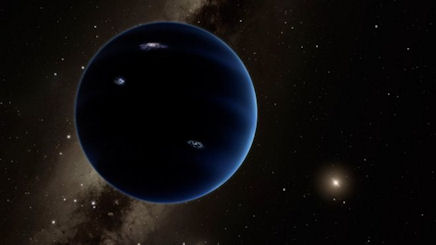
Image Credit: Robert Hurt, IPAC/Caltech
In addition, the presence of a distant, sizeable Planet X object, whose closest approach to the Sun is argued to be 250 Astronomical Units away (3), could be affecting the tilt of the entire planetary system orbiting the Sun.
"Using an analytic model for secular interactions between Planet Nine and the remaining giant planets, here we show that a planet with similar parameters can naturally generate the observed obliquity as well as the specific pole position of the sun's spin axis, from a nearly aligned initial state. Thus, Planet Nine offers a testable explanation for the otherwise mysterious spin-orbit misalignment of the solar system." (3)
The key to this quite dramatic effect is the high inclination of Planet Nine's projected orbital plane with respect to the rest of the solar system, rather than the object's inherent mass. This point was made by Alessandro Morbidelli (2) who, along with his colleagues, has also published similar work at the same time as the Caltech team. Their work goes further, providing a series of scenarios for the orbit of Planet Nine, and thus offering further constraints upon its present position:
"Under some specific configurations for planet 9, this precession [of plane of the planets relative to the total angular momentum vector of the Solar System] can explain the current tilt of approximately 6 degrees between the invariant plane of the giant planets and the solar equator. ...Some of the planet 9 configurations that allow explaining the current solar tilt are compatible with those proposed to explain the orbital confinement of the most distant Kuiper belt objects. Thus, this work on the one hand gives an elegant explanation for the current tilt between the invariant plane of the inner giant planets and the solar equator and, on the other hand, adds new constraints to the orbital elements of planet 9." (4)
Over very long time periods, the computer simulations independently deployed by both team shows that Planet Nine might generate the observed solar system anomalies naturally. Significantly, this would imply that Planet Nine would have to have taken its place within the ranks of the planets quite early on in the lifetime of the solar system. This, in turn, implies that its orbit is a stable feature of the solar system, rather than the result of a relatively recent capture of an exoplanet.
Of course, this is all conjecture based in turn upon hypothesis. It should be pointed out that there are other possible explanations for the tilt of the rotational axis of the Sun, and the relative obliquity of the Sun's equatorial plane compared to the invariant plane of the ecliptic (2). But the existence of a Planet X object at a high inclination could readily explain these effects, as well as the anomalies of the extended scattered disk beyond the Edgeworth-Kuiper Belt.
Written by Andy Lloyd,
30th July 2016
References:
1
) Konstantin Batygin & Michael Brown "Evidence for a Distant Giant Planet in the Solar System" The Astronomical Journal, 151:2, 20 January 2016,2) Rebecca Boyle "Planet Nine may have tilted entire solar system except the sun" 19 July 2016, with thanks to Mark
3) Elizabeth Bailey, Konstantin Batygin & Michael Brown "Solar Obliquity Induced by Planet Nine" The Astronomical Journal, 152: 126, 20 July 2016
4) Rodney Gomes, Rogerio Deienno & Alessandro Morbidelli "The inclination of the planetary system relative to the solar equator may be explained by the presence of Planet 9" The Astronomical Journal, 153: 27, 18 Jul 2016
5) Shannon Hall "Planet Nine might be an exoplanet stolen by the sun" 4 April 2016
More Support for Dwarf System Habitability
New computer-simulations of atmospheres around
exoplanets close to red dwarf stars show that an
'air-conditioning' system could enable conditions for
life, even when those planets are 'tidally locked' (1).
Astronomers from the Netherlands were following up on
previous work last year which examined various scenarios
to do with air-currents moving around tidally-locked
exoplanets, and the transfer of heat from the
permanently lit side to the permanently dark side of
these 'moons' (2,3). Essentially, then, these
processes potentially create an air-conditioning system
which serves to moderate temperatures across the planet.
This time, Dr Ludmilla Carone and her team considered
the levels of friction between surface features and
these disruptive current of air and weather, and how
these might affect the cooling process globally:
"The KU Leuven researchers
created models in which the surface-atmosphere
interaction on the exoplanet is the same as on Earth,
and models in which there is ten times as much
interaction as on Earth. In the latter case, the
exoplanets had a more habitable climate. If planets with
a well-functioning ‘air conditioning’ system also have
the right atmosphere composition, there’s a good chance
that these exoplanets are habitable." (4) This kind of modelling is important because it shows
that life might exist in the short 'Goldilocks zones' around dwarf
stars. Planets contained within these zones are necessarily
located close to the red and brown dwarf stars themselves, and are
likely subject to the same forces which have made our Moon
tidally-locked, such that only one face of the Moon is ever seen from
the Earth (this is because the Moon spins at the same rate as it rotates
around the Earth). If, as is likely over long time periods,
similar exoplanets become tidally locked around their nearby parent
stars, then only one side of these planets will ever benefit from the
warmth and light these dwarf stars provide. This could create
extreme temperatures on the light and dark sides, but a dynamic
atmospheric system would serve to shift heat around, moderating these
extremes. However, the issue of tidal-locking
may not be that much of an issue, even for the most
closely-bound exoplanets orbiting dwarf stars.
Last year, work published by a team from Canada
considered whether the presence of an atmosphere around
an inner exoplanet would itself prevent
tidal-locking from taking hold (5). If the
atmosphere of the exoplanet is sufficiently thick, then
solar heating drives winds that redistribute the mass of
the atmosphere. Such an effect is known to
drive Venus into a retrograde rotation, for instance
(6). This effect may be sufficient to off-set the
forces that lead to tidal-locking, allowing inner
exoplanets to maintain a day/night system. Written by Andy Lloyd,
References:
1
) Anthony Wood "Are tidally locked exoplanets more habitable than we once thought?" 15 July 2016, with thanks to Mark2) Karl Weinand "A Second Wind for Exoplanets Habitability" September 2015
3) Ludmila Carone et al. "Connecting the dots – II. Phase changes in the climate dynamics of tidally locked terrestrial exoplanets", MNRAS, 453: 3, Pp. 2412-2437, 13 September 2015,
mnras.oxfordjournals.org article
4) Ludmila Carone and Leen Decin, KU Leuven Press Release "Surface composition determines temperature and habitability of a planet" 14 July 2016,
5) PhysOrg "Planets outside our solar system more hospitable to life than thought" 15 January 2016
6) Jérémy Leconte et al. "Asynchronous rotation of Earth-mass planets in the habitable zone of lower-mass stars", Science, 347:6222, pp. 632-635, 6 Feb 2015,
Water-bearing Clouds in Brown Dwarf Atmosphere
A 4.5-5.2 micrometer spectrum of the nearby 5Mj sub-brown dwarf WISE 0855 has allowed astronomers to verify the existence of water in its atmosphere (1). Indeed, they have discovered that the atmosphere of this very cold brown dwarf 'star' bears a great similarity to that of the gas giant Jupiter.
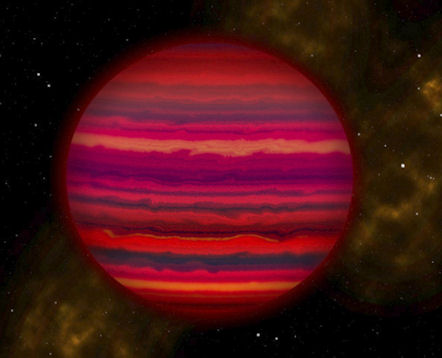
Image credit: Joy Pollard, Gemini Observatory/AURA
Among the findings is increasingly strong evidence for the existence of clouds of water, or water ice, in its atmosphere (2), adding to previous similar findings (3). Water ice? This really is a cold 'star', whose frosty atmosphere exhibits sub-zero temperatures thought to range between −48 and −13 °C, similar to that of our North Pole. These are the first water/water ice clouds detected outside our solar system, and occur in a cold brown dwarf whose colouring is, rather counter-intuitively for such a cold object, remarkably red (5).
Written by Andy Lloyd,
9th-17th July 2016
References:
1
) Astronomy Now "Evidence of water clouds found in spectrum of coldest brown dwarf" 7 July 20162) Andrew Skemer et al. "The First Spectrum of the Coldest Brown Dwarf", Astrophysical Journal Letters, 826:L17, 16 May 2016
3) Jacqueline K. Fahert et al. "Indications of Water Clouds in the Coldest Known Brown Dwarf", Astrophysical Journal Letters, 793: (1), 8 September 2014,
4) Whitney Clavin & J.D. Harrington "NASA's Spitzer and WISE Telescopes Find Close, Cold Neighbor of Sun" 25 April 2014
5) Adam C. Schneider, et al. "The Collapse of the Wein Tail in the Coldest Brown Dwarf? Hubble Space Telescope Near-Infrared Photometry of WISE J085510.83–071442.5", Astrophysical Journal Letters, 823: 2, 27 May 2016
4Mj Dark Star found in Triple Star System
A young 'Dark Star', weighing in at 4 Jupiter masses, is one of only a few such exoplanets to have been directly imaged. It's also a rather curious object for another reason: It's orbiting the main star of a triple star system some 340 light years away, in a dynamical arrangement which lies on the very edge of mathematical possibility (1). HD131399ab is just 16 million years old, and could be classified as an ultra cool sub-brown dwarf rather than a Jovian class gas giant. At this youthful age its temperature is about 600 degrees Celsius, allowing it to be directly imaged in infra-red by SPHERE operated by the European Southern Observatory.
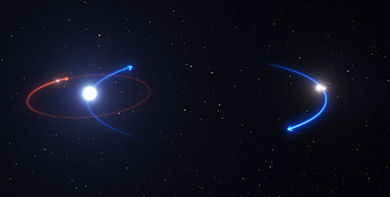
The orbit of the planet in the HD 131399 system (red line) and the orbits of the stars (blue lines).
Image Credit: ESO
The triple star system is indeed curious. The two minor stars (B and C) orbit the main star A at a distance of about 300 Astronomical Units, all the time twirling around each other at approximately Saturn's distance from the Sun. The newly discovered exoplanet, HD131399ab, also orbits around the main star A in a wide orbit "about twice as large as Pluto's if compared to our solar system, and brings the planet to about one-third of the separation of the stars [B & C] themselves." (2).
The massive planet's orbit around its parent star is by far the widest known orbit within a multi-star system.
"The location of HD 131399Ab on a wide orbit in a triple system demonstrates that massive planets may be found on long and possibly unstable orbits in multi-star systems. HD 131399Ab is one of the lowest mass (4 ± 1 MJup) and coldest (850 ± 50 K) exoplanets to have been directly imaged." (3)
According to the University of Arizona team's calculations, this set-up is barely stable over the long-term, and could very easily result in the ejection of HD131399ab if any of the system's variables were to alter. Future data should firm up a more accurate model of this star system (2), and perhaps provide some insight into how this unusual configuration arose in the first place. It's certainly difficult to explain how such a massive planet, of four Jupiter masses, has found itself located twice the distance from its parent star than Pluto is from the Sun at such an early point in its lifetime.
The paper's authors think it is likely that it initially formed closer to its parent star, and then migrated outwards. It has managed to achieve a distance which is as close to getting flung out of the system as one could reach before HD131399ab becomes a free-floating interstellar sub-brown dwarf (1). The authors seem torn between thinking this is a migrating system on the verge of ejection of the massive planet, or just possibly the tip of an iceberg of exotic planet-forming possibilities in outer solar system environments. Either way, this quirky system indicates how complex wide orbit arrangements can become.
As a mental experiment, imagine a similar scenario in our own solar system where a highly distant binary Dark Star lives alongside a quite separate wide orbit Planet X object. One might then begin to see a picture emerging of a really quite complex outer solar system configuration - one that might align with recent calculations attempting to reconcile the complex perturbing effects of the proposed Planet Nine (4,5).
Written by Andy Lloyd,
8th July 2016
References:
1
) Ryan Mandelbaum "This could be the Strangest Exoplanet Yet" 7 July 2016, with thanks to Mart2) Daniel Stolte "Newly discovered planet has 3 suns" 7 July 2016
3) K. Wagner et al. "Direct Imaging Discovery of a Jovian Exoplanet Within a Triple Star System", Science, 353:6300, 7 July 2016
4) Paul Seaburn "New Evidence For Existence of Planets Ten and Eleven" 15 June 2016
mysteriousuniverse.org article
5) Carlos de la Fuente Marcos, Raúl de la Fuente Marcos & Sverre J. Aarseth "Dynamical impact of the Planet Nine scenario: N-body experiments" Monthly Notices of the Royal Astronomical Society: Letters, 2016, 460 (1): L123-L127, 21 July 2016)

You can keep informed of updates by following me on Twitter:
![]()
Or like my Facebook Page: https://www.facebook.com/darkstarandylloyd